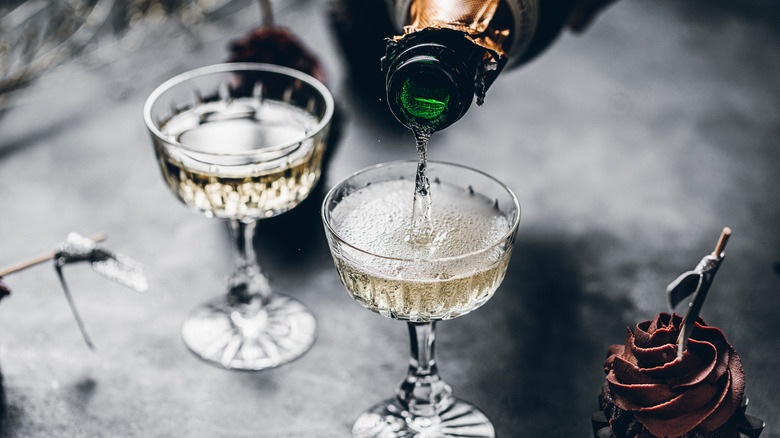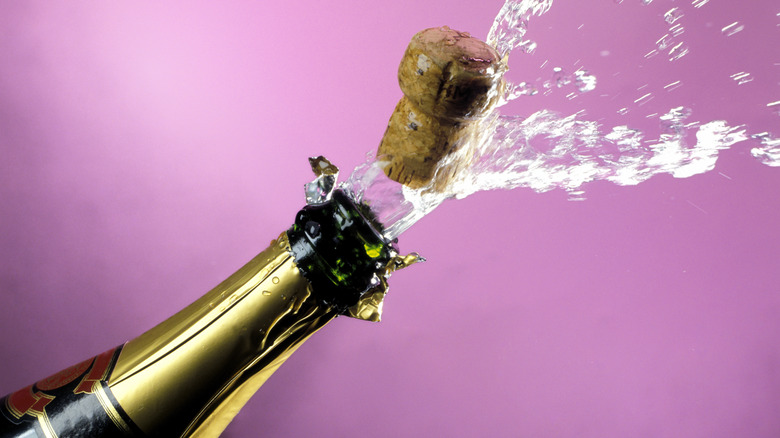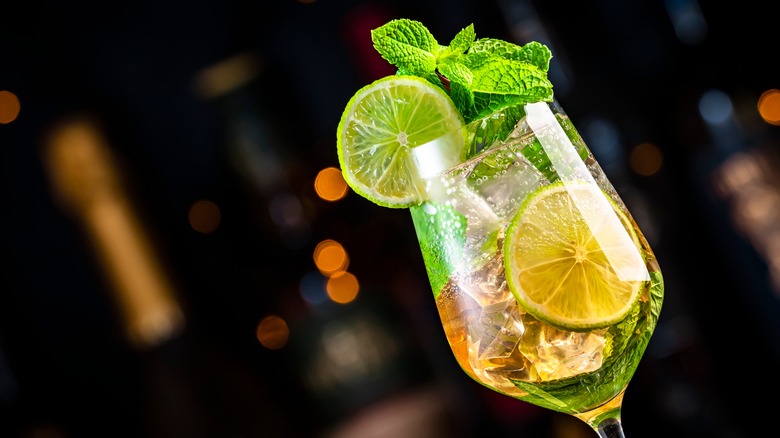The Popular Champagne Spoon Hack That Doesn't Actually Work
Once you've uncorked a bottle of red or white wine, it's easy enough to stick the cork back in the bottle to enjoy it another day. But anyone who's popped the cork on a bottle of champagne (or any other sparkling wine) knows that, once out, those corks expand to the point where they aren't going anywhere but either the trash or a keepsake drawer. (This is because, once opened, sparkling wines tend to be consumed pretty quickly — meaning the cork resumes its original, pre-bottling shape.) So, how do you store an opened bottle of sparkling wine without it going flat? Many people claim that putting a metal spoon, handle-side down, in the mouth of the bottle will do the trick. The only problem with this seemingly elegant hack is that it doesn't actually work — making it one of several mistakes to avoid when drinking champagne.
The general idea is that the metal spoon absorbs and retains the refrigerator's chilliness and therefore holds the bubbles in the bottle because of the increased density of the cold air surrounding it. There's just enough truth in this explanation to sound plausible. But science people have actually studied this very thing (we're talking Stanford researchers as well as researchers from France's Interprofessional Committee of Champagne). None of them found that the spoon trick prevented any loss of carbonation.
The spoon hack myth
So, what's that kernel of truth inherent in the spoon hack? It has to do with the solubility of carbon dioxide in low-temperature liquids. In lay terms, the colder the liquid, the higher the ability of carbon dioxide gas to stay dissolved inside it. All this spoon hack stuff about denser air doesn't hold up under scientific scrutiny. So what's the takeaway? An opened bottle of sparkling wine put back in the fridge without a spoon will lose its effervescence at the same rate. It will also, spoon or no spoon, be busy absorbing whatever other flavors and odors your fridge has to offer. The bottom line is that as soon as you've opened a bottle of bubbly, it begins to deteriorate.
This deterioration has as much to do with another gas, oxygen, as carbon dioxide. As soon as any bottle of wine is opened, oxygen in the atmosphere starts converting alcohol (more properly, ethanol) into acetaldehyde. (This process, called oxidation, is also what turns your cut apples brown.) While newly-opened vintage wines will "open up" in the presence of oxygen (swirling them in the glass speeds this process up), after a few days of being open, they (like any wine) will get over-oxidized and end up tasting like copper and vinegar.
How to properly store sparkling wine
The best way to preserve a sparkling wine's effervescence is by sealing the bottle with a so-called hermetic cork or champagne stopper (they'll provide a seal which even the pressure from the carbonated liquid can't permeate) and keeping the bottle well chilled. You can also reuse the cork from another bottle of wine if you happen to have one lying around — just be sure to push it pretty far in lest it become a refrigerated projectile!
If you don't have any of those things to hand, securing a piece of clean aluminum foil or plastic wrap over the top of the bottle will slow down the oxidation process, if not the loss of carbon dioxide. Pop it back in the fridge until you're ready to finish it off the next day, say as part of an elderflower spritz – because even when properly stored, an open bottle of sparkling wine won't be much good to drink after much longer than three days.


